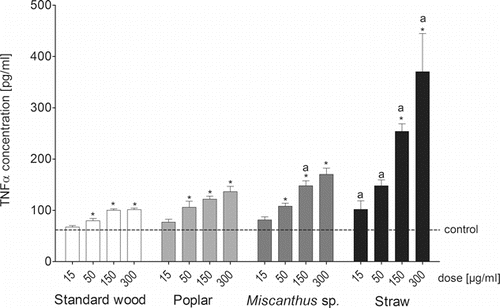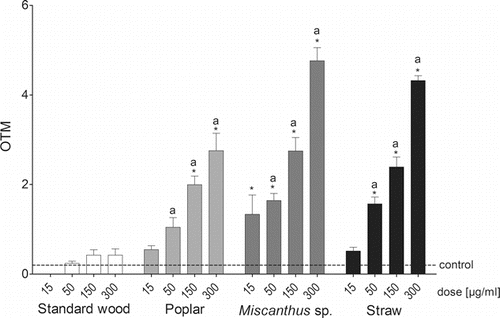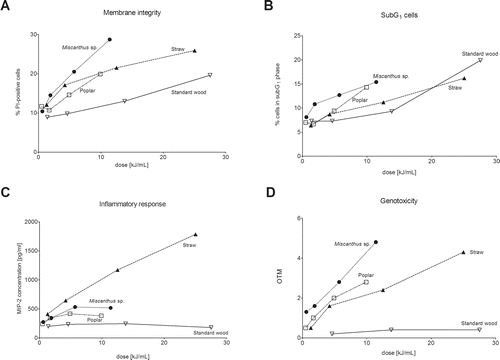Figures & data
Table 1. Overview of the different pellet fuels used in this study and their emissions.
Table 2. Carbonaceous and chemical compositions [in ng/mg PM mass] of the PM emission samples from different biomass fuels.
Figure 1. Production of the pro-inflammatory marker TNFα by RAW264.7 macrophages after a 24-h exposure of the cells to four doses (15, 50, 150, and 300 µg/mL) of PM1 samples from the combustion of different pellet fuels. Bars represent the average concentration of TNFα in pg/mL and whiskers represent the standard error of the mean (SEM). Asterisks indicate statistical significance relative to the negative control; “a” indicates a statistically significant difference relative to standard softwood pellet combustion (ANOVA/Dunnett's; n = 6, p ≤ 0.05).

Figure 2. Cell viability of RAW264.7 macrophages assessed with (a) the MTT test and (b) the PI exclusion assay and (c) by flow cytometric analysis of the cell cycle/SubG1-cells after a 24-h exposure of the cells to four doses (15, 50, 150, and 300 µg/mL) of particulate samples from the combustion of different pellet fuels. Each bar represents the experimental mean + standard error of the mean (SEM). Asterisks indicate statistical significance relative to the negative control; “a” indicates statistical significance relative to the standard softwood pellet sample (PI exclusion and SubG1-cells: Kruskal-Wallis: n = 3, p ≤ 0.05, MTT: ANOVA/ Dunnett's; n = 6, p ≤ 0.05).

Figure 3. DNA damage evaluation by the SCGE assay in RAW264.7 cells after a 24-h exposure to three (sample standard softwood pellets, 50, 150, and 300 µg/mL) or four different concentrations (15, 50, 150, and 300 µg/mL) of particulate samples from the combustion of different pellet fuels expressed as the olive tail moment (OTM: (tail.mean-head.mean) x (tail%DNA/100)). Each bar represents the experimental mean + standard error of the mean (SEM). Asterisks indicate statistical significance relative to the negative control; a indicates statistical significance relative to the standard softwood pellet sample (Kruskal–Wallis n = 3, p ≤ 0.05).

Figure 4. Relative toxicity of four selected endpoints: (a) membrane integrity as assayed by PI exclusion assay, (b) cells in the SubG1-phase as assayed by cell cycle analysis, (c) inflammation assayed by measurement of MIP-2, and (d) genotoxicity assayed by the SCGE assay. The scale on the X-axes is the PM1 dose in µg/mL divided by the amount of PM1 emitted per MJ of obtained energy.

Table 3. Spearman correlation coefficients (ρ) between the chemical constituents of the particulate samples from the combustion of different pellet fuels and the toxicological responses of RAW264.7 cells.
